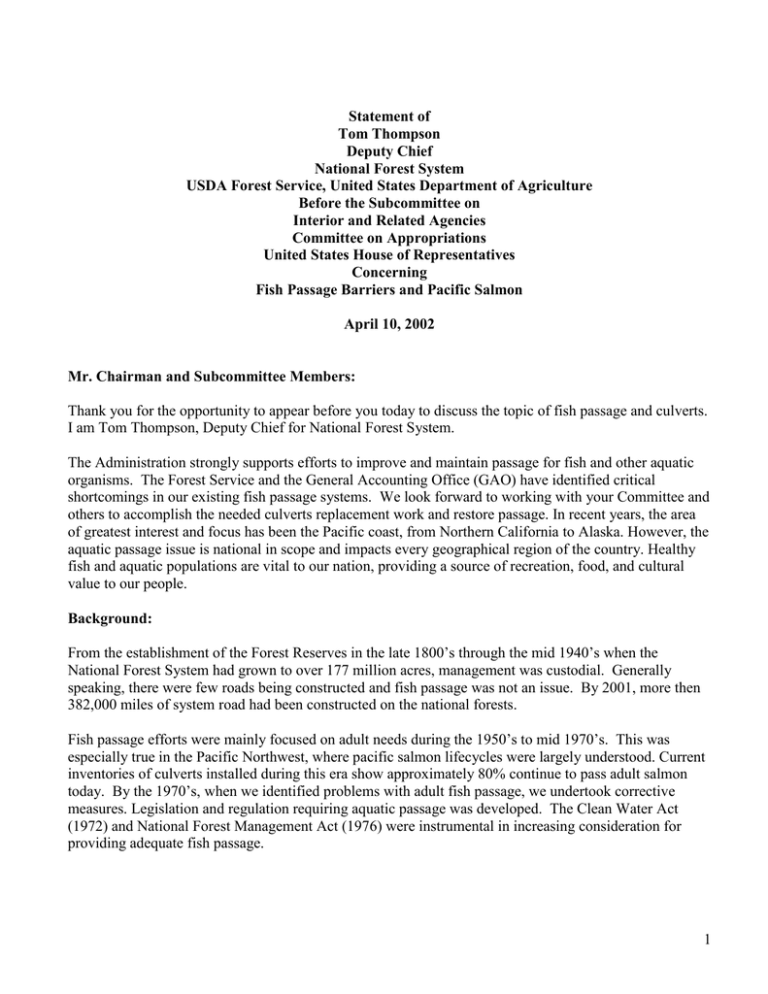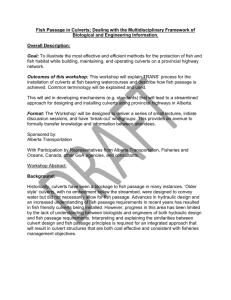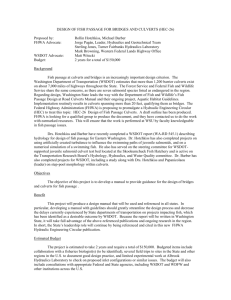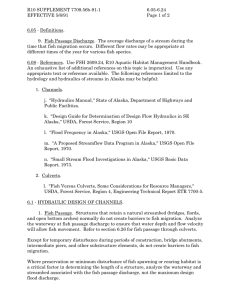Statement of Tom Thompson Deputy Chief
advertisement

Statement of Tom Thompson Deputy Chief National Forest System USDA Forest Service, United States Department of Agriculture Before the Subcommittee on Interior and Related Agencies Committee on Appropriations United States House of Representatives Concerning Fish Passage Barriers and Pacific Salmon April 10, 2002 Mr. Chairman and Subcommittee Members: Thank you for the opportunity to appear before you today to discuss the topic of fish passage and culverts. I am Tom Thompson, Deputy Chief for National Forest System. The Administration strongly supports efforts to improve and maintain passage for fish and other aquatic organisms. The Forest Service and the General Accounting Office (GAO) have identified critical shortcomings in our existing fish passage systems. We look forward to working with your Committee and others to accomplish the needed culverts replacement work and restore passage. In recent years, the area of greatest interest and focus has been the Pacific coast, from Northern California to Alaska. However, the aquatic passage issue is national in scope and impacts every geographical region of the country. Healthy fish and aquatic populations are vital to our nation, providing a source of recreation, food, and cultural value to our people. Background: From the establishment of the Forest Reserves in the late 1800’s through the mid 1940’s when the National Forest System had grown to over 177 million acres, management was custodial. Generally speaking, there were few roads being constructed and fish passage was not an issue. By 2001, more then 382,000 miles of system road had been constructed on the national forests. Fish passage efforts were mainly focused on adult needs during the 1950’s to mid 1970’s. This was especially true in the Pacific Northwest, where pacific salmon lifecycles were largely understood. Current inventories of culverts installed during this era show approximately 80% continue to pass adult salmon today. By the 1970’s, when we identified problems with adult fish passage, we undertook corrective measures. Legislation and regulation requiring aquatic passage was developed. The Clean Water Act (1972) and National Forest Management Act (1976) were instrumental in increasing consideration for providing adequate fish passage. 1 In the late 1970’s and 1980’s, the Forest Service research efforts were greatly expanded and focused on improving the understanding of fish migration and behavior, engineering solutions to slow water under roads, and stream hydrology. Engineering and biological research resulted in a much-improved knowledge of fish passage design criteria and the development of open bottom structures. Unlike culverts, open structures do not constrict the natural stream channel and negatively affect fish passage. Biological research also showed the need to provide passage for juvenile fish and other less vigorous swimming aquatic organisms such as amphibians. Hydrology research improved our understanding of discharge regimes for small streams and land management-induced changes. Culvert sizing methodology was greatly improved. Research results were transferred to technical and professional field employees through the development of handbooks, training programs, and other aids. After decades of learning and hard work, we are now able to consistently design and construct streamcrossing structures that assure fish passage and survive major storm events. There will be more advances in the future as we continue to study aquatic invertebrates and other fish species, particularly those found in areas of high biodiversity such as the southern states. Current Fish Passage Assessment: In recent decades, the Forest Service has emphasized replacing culverts that didn’t pass aquatic organisms. We have incorporated culvert replacement as a priority in our aquatic restoration program. Many culverts were replaced through timber sale contracts, special flood repair programs, and regular appropriations. We have also developed and implemented a road analysis process. This process insures that our transportation road system is periodically assessed for current and future needs. In 2000 – 2001, the GAO examined fish passage issues on Bureau of Land Management (BLM) and Forest Service managed lands in the States of Washington and Oregon. Based on information provided by the Forest service, the GAO report identified culvert replacement needs in the states of Oregon and Washington at $331 million and estimated the work would take decades. Since that time, the Forest Service has continued to inventory additional culverts for passage concerns. We have also conducted inventories in Alaska, Northern California and other geographical areas. The table below depicts the current situation for the Forest Service as of March 2002. 2 Forest Service Region Estimated Number of Number Number of Total number of culverts of additional identified culverts on assessed barrier barrier and fish for culverts culverts estimated streams passage identified estimated Alaska R10 Alaska 2016 1490 1311 263 1574 Pacific Northwest R6 Oregon Washington 3700 1800 2900 1400 2800 600 500 1020 3300** 1620** Pacific Southwest R5 California 67*** 447* 32*** 20*** 52*** 7583 6237 4743 1803 6546 TOTALS * anadromous and resident fish streams ** includes multiple pipes at one crossing *** anadromous streams only Culvert inventories are in progress or planned in all of the other regions as well as the non-anadromous portion of R-5. Regions 1, 5, 6, and 10 are planned for completion by FY2004. FY2003 Budget Summary: The President’s 2003 budget for the Forest Service has proposed approximately $241 million for the Road Construction and Maintenance budget line item, $15 million for the 10 Percent Roads and Trails fund, and approximately $51 million for Infrastructure Improvement. It is estimated that $65 million of these funds will be used to fund critical deferred maintenance for roads. The remaining funds will be used for timber sale roads support, critical deferred maintenance for trails and facilities, critical annual road maintenance needs and indirect costs. Region 6 estimates $12.5 million will be utilized on culvert replacement activities in FY2002. Strategy: Our strategy to address the culvert replacement backlog includes: Continuing the culvert inventory and road analysis process. 3 Prioritizing replacement sites so public benefits are maximized. We will continue to replace culverts that provide the greatest benefit first, both in terms of miles of stream opened up and improving the status of federally listed or sensitive species. As referenced in the GAO report and Statement of Action, implement a post project monitoring protocol for new and existing culvert sites. Improving our understanding of passage needs for other aquatic organisms, especially in the Southeast United States. The Forest Service is committed to improving aquatic organism passage by working cooperatively with Congress, Tribal groups, State and local governments, interest groups, private landowners, and regulatory and other land management agencies in a total watershed approach. The Administration fully supports healthy aquatic ecosystems and recognizes the great benefit to people and communities. Thank you for holding this important hearing and I would be pleased to answer any questions you or members of your Subcommittee may have. 4







